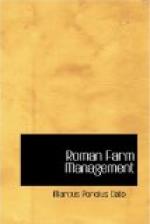[Footnote 47: To this glowing description of agricultural Italy in the Augustan age may be annexed that of Machiavelli on the state of Tuscany in his youth: “Ridotta tutta in somma pace e tranquillita, coltivata non meno ne’ luoghi piu montuosi e piu sterili che nelle pianure e regioni piu fertili....” It is our privilege to see the image of this fruitful cultivation of the mountain tops not only in Machiavelli’s prose, but on the walls of the Palazzo Riccardi in Gozzoli’s Journey of the Magi, where, like King Robert of Sicily, the Magi crossed
“Into the lovely land of Italy
Whose loveliness was more resplendent
made
By the mere passing of that cavalcade.”
It seems almost a pity to contrast with these the comment of a careful and sympathetic student of the agricultural Italy of the age of King Umberto: “To return to the question of the natural richness of agricultural Italy,” says Dr. W.N. Beauclerk in his Rural Italy (1888), “we may compare the words of the German ballad: ’In Italy macaroni ready cooked rains from the sky, and the vines are festooned with sausages,’ with the words today rife throughout the Kingdom, ’Rural Italy is poor and miserable, and has no future in store for her.’ The fact is that Italy is rich in capabilities of production, but exhausted in spontaneous fertility. Her vast forests have been cut down, giving place to sterile and malarious ground: the plains and shores formerly covered with wealthy and populous cities are now deserted marshes: Sardinia and other ancient granaries of the Roman Empire are empty and unproductive: two-thirds of the Kingdom are occupied by mountains impossible of cultivation, and the remainder is to a large extent ill-farmed and unremunerative. To call Italy the ‘Garden of Europe’ under these circumstances seems cruel irony.”]
[Footnote 48: As we may assume that the yields of wine of which Fundanius boasts were the largest of which Varro had information in the Italy of his time, it is interesting to compare them with the largest yields of the most productive wine country of France today. Fifteen cullei, or three hundred amphorae per jugerum, is the equivalent of 2700 gallons per acre: while according to P. Joigneaux, in the Livre de la Ferme, the largest yields in modern France are in the Midi (specifically Herault), where in exceptional cases they amount to as much as 250 hectolitres to the hectare, or say 2672 gallons per acre. It may be noted that the yields of the best modern wines, like Burgundy, are less than half of this, and it is probable that the same was true of the vinum Setinum of Augustus, if not of the Horatian Massic.]
[Footnote 49: The modern Italian opinion of farming in a fertile but unhealthy situation is expressed with a grim humour in the Tuscan proverb: “in Maremma s’arricchisce in un anno, si muore in sei mesi.”]




